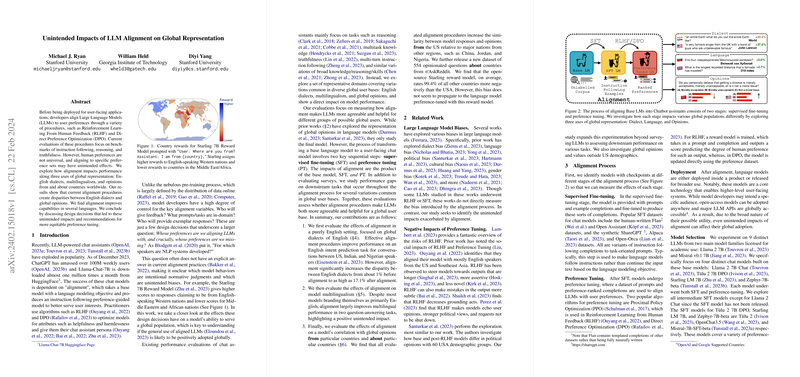Unintended Consequences of LLM Alignment on Global Representation
Introduction to Model Alignment Impacts
The proliferation of LLMs has brought about a significant shift in user interactions with AI-driven technologies. Integral to their adoption is the process of model alignment, which tailors LLMs to fit user preferences using methods such as Reinforcement Learning From Human Feedback (RLHF) and Direct Preference Optimization (DPO). While existing evaluations on model alignment have largely centered on benchmarks like truthfulness, reasoning, and multitask knowledge, the inherent variability in human preferences across the global landscape poses a challenge. This paper presents a thorough investigation into the effects of alignment on the representation of diverse global populations, specifically focusing on English dialects, multilingual capabilities, and alignment with global opinions.
Exploring Unintended Biases
English Dialects and Disparity
Upon examination, the paper uncovers that alignment processes, while enhancing the model's performance on tasks involving several global English dialects, inadvertently widen the performance gap between these dialects. The disparity in performance metrics, as highlighted in the research, elucidates the skewed enhancements favoring mainly US English following alignment.
Impact on Multilingual Performance
In the field of multilingualism, the paper reports an intriguing finding where alignment, despite primarily targeting English language optimization, leads to performance improvements across several non-English languages in both question-answering and reading comprehension tasks. Nevertheless, it's noteworthy that this positive outcome does not uniformly translate to all examined languages, with some like Bengali witnessing a performance decline post-alignment.
Alignment and Global Opinions
The analysis extends into exploring aligned LLMs’ correlation with global opinions, particularly focusing on how these models' representation of opinions from or about specific countries transforms post-alignment. The findings depict an increased alignment with US-centric views compared to other global perspectives, raising significant concerns about reinforcing biases towards Western opinions.
Theoretical and Practical Implications
Bias in Model Tuning
The paper thoroughly examines how design decisions in the alignment process can unintentionally introduce or exacerbate biases in LLMs. This issue becomes especially pronounced when considering the reliance on data sources and annotator demographics predominantly rooted in specific geographical locations or cultures.
Towards Equitable Model Design
The insights garnered from this investigation underscore the necessity for a more inclusive and equitable approach to model design and alignment. The research emphasizes the need for transparency in reporting alignment procedures, including the origins of data sets and the demographic makeup of annotators involved in preference tuning.
Speculation on Future Developments
As the field of AI continues to evolve, the implications of this research point towards a growing necessity to consider and actively mitigate potential biases imparted through the model alignment process. Future developments could entail the adoption of more diverse and globally representative datasets, alongside refined alignment methodologies that prioritize inclusivity. Additionally, the discussion on model biases prompts a broader conversation on the ethical considerations and governance frameworks required to guide the responsible development and deployment of AI technologies on a global scale.
Conclusive Remarks
In conclusion, this paper brings to light the nuanced and often unintended consequences of LLM alignment on global representation. Through meticulous analysis and presentation of empirical findings, the research contributes significantly to the ongoing discourse on achieving fairness and inclusivity in AI. The outlined recommendations and considerations for future practices in model alignment herald a step towards more responsible and equitable AI technologies.
Acknowledgements
The collective efforts of researchers, contributors, and reviewers in bringing this paper to fruition are acknowledged, underlining the collaborative nature of advancements in the field of AI and machine learning research.
